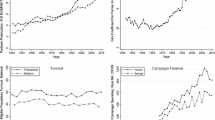Abstract
We introduce an extension of the Esteban and Ray [Econometrica, 62:819–851 1994] measure of polarization that can be applied to density functions. As a by-product we also derive the Wolfson [Am. Econ. Rev., 84:353–358 1994] measure as a special case. This derivation has the virtue of casting both measures in the context of a (statistically) unified framework. We study the polarization of the distribution of household income for five OECD countries (LIS database): US, UK, Canada, Germany and Sweden.
Similar content being viewed by others
References
Anderson, G.: Toward an empirical analysis of polarization. J. Econ. 122, 1–26 (2004)
Anderson, G.: “Polarization”, mimeo, Department of Economics, University of Toronto (2005)
Aghevli, B.B., Mehran, F.: Optimal grouping of income distribution data. J. Am. Stat. Assoc. 76, 22–26 (1981)
Chakravarty, S., Majumder, A.: Inequality, polarization and welfare: Theory and applications. Aust. Econ. Papers 40, 1–13 (2001)
Chakravarty, S., Majumder, A., Roy, S.: A treatment of absolute indices of polarization. Mimeo, forthcoming in The Japanese Economic Review (2002)
Davies, J.B., Shorrocks, A.F.: Optimal grouping of income and wealth data. J. Econ. 42, 97–108 (1989)
Duclos, J-Y., Esteban, J., Ray, D.: Polarization: Concepts, measurement, estimation. Econometrica 72, 1737–1772 (2004), reprinted in Christopher Barrett (ed.) The Social Economics of Poverty: On Identities, Groups, Communities, and Networks. Routledge, London (2005)
Esteban, J., Ray, D.: On the measurement of polarization. Econometrica 62, 819–851 (1994)
Esteban, J., Gradín, C., Ray, D.: Extensions of a Measure of Polarization, with an Application to the Income Distributions of Five OECD Countries. Working Paper 24, Instituto de Estudios Económicos de Galicia-P. Barrié de la Maza, A Coruña, Spain. Also in: Luxembourg Income Study (LIS) Working Paper Series, 218, Maxwell School of Citizenship and Public Affairs, Syracuse University, Syracuse, New York (1999)
Gradín, C.: Polarization by sub-populations in Spain, 1973–91. Rev. Income Wealth 46(4), 457–474 (2000)
Love, R., Wolfson, M.C.: Income Inequality: Statistical Methodology and Canadian Illustrations, Catalogue 13–559 Occasional. Ottawa, Statistics Canada (1976)
Montalvo, J., Reynal-Querol, M.: Ethnic polarization, potential conflict, and civil wars. Am. Econ. Rev. 95, 796–816 (2005)
Reynal-Querol, M.: Ethnicity, political systems, and civil wars. J. Confl. Resolut. 46, 29–54 (2002)
Salas, R., Rodríguez, J.G.: Extended bi-polarization and inequality measures. Res. Econ. Inequal. 9, 69–83 (2002)
Wang, Y., Tsui, K.: Polarization orderings and new classes of polarization indices. J. Public Econ. Theory 2(3), 349–363 (2000)
Wolfson, M.C.: When inequalities diverge. Am. Econ. Rev. 84, Papers and Proceedings, 353–358 (1994)
Zhang, X., Kanbur, R.: What difference do polarization measures make? An application to China. J. Dev. Stud. 37(3), 85–98 (2001)
Author information
Authors and Affiliations
Corresponding author
Additional information
The present paper is essentially based on Esteban, Gradín and Ray [9], published as #218 in the working papers series of the Luxembourg Income Study. Changes have been kept to a minimum. We have provided a brief reference to the literature on polarization measurement that has appeared since then and have updated the data of our application.
Rights and permissions
About this article
Cite this article
Esteban, J., Gradín, C. & Ray, D. An Extension of a Measure of Polarization, with an application to the income distribution of five OECD countries. J Econ Inequal 5, 1–19 (2007). https://doi.org/10.1007/s10888-006-9032-x
Received:
Accepted:
Published:
Issue Date:
DOI: https://doi.org/10.1007/s10888-006-9032-x




